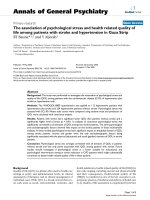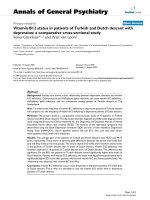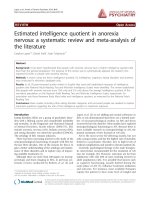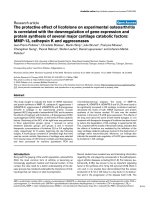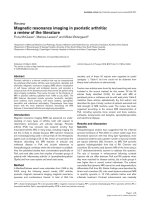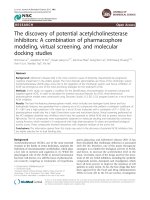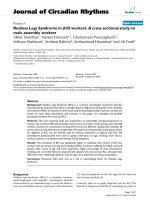Báo cáo y học: "The ‘off-hour’ effect in trauma care: a possible quality indicator with appealing characteristic" pps
Bạn đang xem bản rút gọn của tài liệu. Xem và tải ngay bản đầy đủ của tài liệu tại đây (217.76 KB, 4 trang )
COM M E N TAR Y Open Access
The ‘off-hour’ effect in trauma care: a possible
quality indicator with appealing characteristics
Stefano Di Bartolomeo
Abstract
A recent paper has drawn attention to the paucity of widely accepted quality indicators for trauma care. At the
same time, several studies have measured whether mortality of trauma patients changes between normal working
time and other parts of the day/week, i.e. the so-called ‘off-hour’ or ‘weekend’ effect. This measure has the
characteristics to become an accepted quality indicator because it combines the advantages of both outcome and
process indicators. As an outcome indicator it would not need validation, a procedure particularly difficult in
trauma care where gathering scientific evidence is more difficult than in other disciplines. As a process indicator it
would provide indications about where to intervene to improve quality.
Introduction
Although the importance of quality indicators (QI) is
undisputed, the debate concerning their validity is inces-
sant. A recent systematic review [1] concluded that
‘there is not a common set of clearly defined, evidence-
based and broadly accepted QIs for evaluating the qual-
ity of trauma care.’
A recent study [2] compared the mortality of trauma
patients admitted inside and outside normal working
hours in a North-American trauma system. Evenings,
nights, and weekends were intended as non-working
hours - also referred as ‘after’ or ‘off’ hours, as opposed
to ‘office’ or ‘business’ hours. The study found no differ-
ence, however previous studies that investigated the so-
called ‘weekend’ or ‘off-hour’ effect in various diseases
yielded inconsistent results; sometimes such a difference
was found [3-8,15] and sometimes not [9-15].
This commentary discusses why the evaluation of the
‘off-hour’ effe ct can also be considered a QI. Further-
more, it examines the theoretical characteristics of such
a QI, with a special emphasis on its potential to over-
come the usual obstacles for QIs in trauma care.
Discussion
Quality indicators and scientific evidence
QIs aim at measuring quality. The common definition of
quality by the United States Institute of Medicine is ‘the
degree to which hea lth services for individuals and
populations increase the likelihood of desired health
outcomes and are consistent with current professional
knowledge [16].’ Thus, any QI should be related to a
certain level of the desired health outcomes. Any person
is allowed to consider a n outcome as ‘ desired’ and
devise the consequent QIs. Nevertheless, there is little
doubt that health-care quality ultimately aims at influen-
cing mortality and/or morbidity. Indeed, the above men-
tioned two outcomes are most used QIs themselves,
under the category of ‘outcome indicators’’ of the classic
classification by Donabedian [17]. However, it has been
identified that the effects of quality on mortali ty may be
difficult to measure because of a low signal-to-noise
ratio [18]. It has been suggested to measure the pro-
cesses of care (by the so called ‘process indicators’ )
instead of the outcomes to overcome the above-men-
tioned problem [18]. However, in order to improve the
quality, the processes me asured by such QIs should
‘ increase the likelihood of desired health outcomes.’
Therefore, ‘out through the door, in through the win-
dow’ is the link with survival [19]. The link is usually
provided by research and represents the evidence under-
pinning the QI itself. For instance, first a good level of
evidence (i.e. a survival benefit) was established by
scient ific research for administering beta-blockers in the
emergency room to patients with myocardial infarction.
Subsequently, a QI measuring the actual adherence to
this practice was widely adopted [20,21]. Further
attempts to validate this QI proving its link with the
Correspondence:
Anaesthesia and ICU, University-Hospital, Udine, Italy/Regional Health Agency
of Emilia-Romagna, Bologna, Italy
Di Bartolomeo Scandinavian Journal of Trauma, Resuscitation and Emergency Medicine 2011, 19:33
/>© 2011 Di Ba rtolomeo; licensee BioMed Central Ltd. This is an Open Access article distributed under the terms of the Creative
Commons Attribution License ( which pe rmits unrestricted us e, distribution, and
reproduction in any medium, provided the original work is properly cited.
outcome (i.e. comparing patient survival in th e hospitals
with high adherence vs. hospitals with low adherence)
may be desirable, but not indispensable.
Quality indicators in Trauma Care
Trauma care, as compared to other branches of medi-
cine, suffers from a paucity of evidence, as a result of
underfunding of research [22]. In addition, special diffi-
culties in collecting the information due to some charac-
teristics of trauma care itself, such as multidisciplinarity,
logistic complexity, and eme rgency also result in insuffi-
cient eviden ce. Therefore, a majority of the processes of
care are not supported by evidence. Subsequently, the
respective QIs are also not supported. The ensui ng
attempts to validate these QIs (i.e. the assessment of
their relationship with the patients’ outcomes, usually
mortality ) are not substan tially different from the scien-
tific research into the processes themselves, and are hin-
dered by the same difficulties. Thus, such attempts are
often unsuccessful [1,23-25]. For example, it is reason-
able for an Emergency Medical System to evaluate its
quality through the rate of prehospital intubation of
head-injured patients with GCS <9. However, if a
researcher sought to validate this indicator against survi-
val (the ‘ golden’ outcome), he/she would face the same
uncertainties faced by intubation itself [26].
Hence, it is not by chance that the most used and
accepted QI in trauma care is a straightforward outcome
measure, i.e. the benchmarked risk-adjusted mortality.
The main advantage of the above mentioned QI is that
it does not need validation. However, the main disad-
vantage is that it does not refe r to specific processes of
care. As a consequence, the quality-makers remain in
search of valid process indicators at the time of identify-
ing and targeting the causes of mortality differences.
The ‘off-hour’ effect as a quality indicator
Mortality in ‘after time’ versus ‘business time’ expresses
whether the quality of care is the same during the differ-
ent time periods being compared. This analysis is mean-
ingful and of practical interest as everybody is aware of
thepossibledeficienciesintraumacareduringafter-
hours. Such deficiencies are caused by the differential
availability of staff, facilities, resources and procedures,
by fatigue or sleepiness of the personnel and by
increased logistic difficulties in pre-hospital rescue (e.g.
flight restrictions for helicopters at night).
Similar to the benchmarked risk-adjusted mortality,
the investigation of the ‘off-hour’ effect would enjoy the
important benefit of being an outcome indicator. There-
fore, this indicator would not require validation against
the outcome. At the same time though, differently from
the benchmarked adjusted mortality, it does not mea-
sure the quality of care on the whole, but just a portion
of it. Therefore, it could act as a process indicator as
well, a nd help identify the processes that should be tar-
geted to improve the quality of care. For example, this
QI might drive interventions to increase the staffing of
hospitals during weekends or launch a night flight
HEMS program. Moreover, the re-calculation of the QI
at a later time could assess the efficacy of the above-
mentioned interventions. On the other hand, the
absence of the ‘off-hour’ effect could be a sort of a qual-
ity mark for hospitals or systems whose specific pro-
cesses of care could then become models for others to
copy.
Another advant age is that this QI can be calculated at
the local level (trauma center, trauma system or geogra-
phical region) without complex benc hmarking against
data from other settings, a procedure that may be biased
ifthedataareinhomogeneous.Theevaluationofthe
‘off-hour’ effect is an internal comparison, as the com-
pared groups come from the same setting. Thus, unac-
counted differences (e.g. systematic between-hospital
differences in severity score assignment) are less prob-
able. Conceptuall y, it resembles the difference that
occurs between the case-control and case-crossover
study-design [27]. In the f ormer design, cases and con-
trols are different subjects, while in the latter design
cases and controls are the same subjects, though
observed in different times. Consequently, some sources
of potential confounding, i.e. those related to the fixed
characteristics of the unit of analysis do not change
within the matched pairs and are controlled for by the
design.
However, it is necessary to exercise some caution and
understanding. All the factors influencing survival at the
patient level (age, mechanism of injury, injury severity
etc.) should be careful ly accounted and ad justed. This is
because systematic differences may still occur. For
instance, patients admitted in the off hours are known
to be younger, [2] plausibly because the young tend to
go out at night. In addition, penetrating trauma occurs
more often, [2] probably as more violence transpires at
night. Finally, injury severity may be worse because traf-
fic accidents are also more severe at night [28]. For all
the above-menti oned reasons, a crude, unadjusted com-
parison of mortality would not be reasonable. Thus, a
risk-adjusted model would be required for a proper
application of this QI.
Another important caveat is that the aspect of quality
measured by this indicator is relative, and not absolute.
In other words, the absence of the ‘off-hour’ effe ct is
always recommendable, but not sufficient. Even though
it is uncommon, a system with the same mortality in
working and off hours could still have an elevated over-
all mortality, which is disturbing. Therefore, this QI
should not be considered as an alternative to the
Di Bartolomeo Scandinavian Journal of Trauma, Resuscitation and Emergency Medicine 2011, 19:33
/>Page 2 of 4
benchmarked risk-adjusted mortality, but only as
complementary.
This QI would retain its meaningfulness when applied
at any level (e.g. one or more hospitals, one trauma sys-
tem or one geographical area). However, it could cap-
ture the full picture of possible differences between
parts of the day/week only if all the possible hospitals
where a patient could be brought were included. The
processes of care that bring patients from the trauma
scene to the definitiv e hospital are crucial [29]. Further,
these processes are also likely to be affected by the time
of the day. The processes of care would be fully mir-
rored if the indicator were applied at a population-level,
i.e. trauma system or geographical area. Suppose, for
instance only some hospitals within a system (usually
the referrals centers) are considered and the patients
transferred from a nother facility are excluded. Conse-
quently, a possible increase in the mortality caused b y
malfunctioning of the referral system in after hours
could go undetected. For the same reason, the choice of
the variable used to classify patients (time of injury,
time of arrival to 1st hospital or time of arrival to defini-
tive hospital) could also influence the results.
Finally, the detailed definition of the working time
should not be fixed but variable. It should depend on
the characteristics of the setting being analyzed. For
instance, the resources available on a Saturday morning
may resemble those of business time in some hospitals/
systems and those of aftertime in others. Thus, the QI
should be adapted accordingly.
The feasibility of an indicator is an important aspect.
This is b ecause ‘measures based on data that are diffi-
cult to obtain must be extremely valuable or they will
result in misspent resources’ [30] . For this reason,
trauma mortality inside and outside w orking hours
appears feasible, as the necessary data are already part
of the core set recommended by the Utstein Template
(30-day mortality, time of 1
st
emergency call or time of
hospital arrival, and predictive model variables) [31,32].
As mentioned previously, the literature investigating
the ‘off-hour’ effect is inconsistent and divided more or
less equally between the positive and negativ e findings.
Curiously enough, all the studies focusing on trauma
yielded negative results (no difference). However, the
opposite occurred for studies focusing on myocardial
infarction, which is surprising as both these conditions
share many features: time-dependency, early mortality
and the importance of early and centralized care. A
majority of the studies on trauma were conducted in
Level 1 Trauma Centers. These studies used the ti me of
arrival at the hospital to classify the patients and
excluded patients transferred between hospitals. This
could have lowered the chances of finding a difference,
as elucidated above. The other explanation is that the
qualityoftraumacareinthosestudieswasjustgood
enough to protect from the ‘ weekend effect’ .This
appears reasonable given that Level 1 Trauma Centers
have immediate access to a full trauma team at all
times, while interventional cardiologists are rarely in-
house during off-hours.
Conclusions
The evaluation of the ‘off-hour’ effect is a possible qual-
ity indicator for trauma care, which has interesting theo-
retical characteristics. The above-mentioned QI would
not require validation against the outcome, as it is an
outcome indicator. At the same time it could a lso pro-
vide information about the aspects of care that require
improvement, in the manner of a process indicator. The
diffusion of this QI will help to define its value more
precisely. This is because the literature till date demon-
strates that either the developed trauma systems are safe
from the ‘ off-hour’ effect or the way to assess them
needs to be refined.
Competing interests
The author declares that they have no competing interests.
Received: 13 April 2011 Accepted: 9 June 2011 Published: 9 June 2011
References
1. Stelfox HT, Bobranska-Artiuch B, Nathens A, Straus SE: Quality Indicators for
Evaluating Trauma Care. Arch Surg 2010, 145:286-295.
2. Carr BG, Reilly PM, Schwab CW, Branas CC, Geiger J, Wiebe DJ: Weekend
and Night Outcomes in a Statewide Trauma System. Arch Surg 2011.
3. Bell CM, Redelmeier DA: Mortality among patients admitted to hospitals
on weekends as compared with weekdays. N Engl J Med 2001,
345:663-668.
4. Barnett MJ, Kaboli PJ, Sirio CA, Rosenthal GE: Day of the week of intensive
care admission and patient outcomes: a multisite regional evaluation.
Med Care 2002, 40:530-9.
5. Kostis WJ, Demissie K, Marcella SW, Shao YH, Wilson AC, Moreyra AE,
Myocardial Infarction Data Acquisition System (MIDAS 10) Study Group:
Weekend versus weekday admission and mortality from myocardial
infarction. N Engl J Med 2007, 356:1099-109.
6. Peberdy MA, Ornato JP, Larkin GL, et al: Survival from in-hospital cardiac
arrest during nights and weekends. JAMA 2008, 299:785-792.
7. Kuijsten HA, Brinkman S, Meynaar IA, Spronk PE, van der Spoel JI,
Bosman RJ, de Keizer NF, Abu-Hanna A, de Lange DW: Hospital mortality is
associated with ICU admission time. Intensive Care Med 2010, 36:1765-71.
8. Fang J, Saposnik G, Silver FL, Kapral MK, Investigators of the Registry of the
Canadian Stroke Network: Association between weekend hospital
presentation and stroke fatality. Neurology 2010, 75:1589-96.
9. Laupland KB, Ball CG, Kirkpatrick AW: Hospital mortality among major
trauma victims admitted on weekends and evenings: a cohort study.
Journal of Trauma Management & Outcomes 2009, 3:8.
10. Carmody IC, Romero J, Velmahos GC: Day for night: should we staff a
trauma center like a nightclub? Am Surg 2002, 68:1048-51.
11. Carr BG, Jenkins P, Branas CC, Wiebe DJ, Kim P, Schwab CW, Reilly PM:
Does the trauma system protect against the weekend effect? J Trauma
2010, 69:1042-7.
12. Crowley RW, Yeoh HK, Stukenborg GJ, Ionescu AA, Kassell NF, Dumont AS:
Influence of weekend versus weekday hospital admission on mortality
following subarachnoid hemorrhage. Clinical article. J Neurosurg 2009,
111:60-6.
13. Arbabi S, Jurkovich GJ, Wahl WL, Kim HM, Maier RV: Effect of Patient Load
on Trauma Outcomes in a Level I Trauma Center. J Trauma 2005,
59:815-8.
Di Bartolomeo Scandinavian Journal of Trauma, Resuscitation and Emergency Medicine 2011, 19:33
/>Page 3 of 4
14. Guly HR, Leighton G, Woodford M, Bouamra O, Lecky F, Trauma Audit and
Research Network: The effect of working hours on outcome from major
trauma. Emerg Med J 2006, 23:276-80.
15. Clarke MS, Wills RA, Bowman RV, Zimmerman PV, Fong KM, Coory MD,
Yang IA: Exploratory study of the ‘weekend effect’ for acute medical
admissions to public hospitals in Queensland, Australia. Intern Med J
2010, 40:777-83.
16. Lohr KN, Donaldson MS, Harris-Wehling J: Medicare: a strategy for quality
assurance, V. Quality of care in a changing health care environment.
QRB Qual Rev Bull 1992, 18:120-6.
17. Donabedian A: The Definition of Quality and Approaches to Its
Assessment. Ann Arbor, MI, Health Administration press; 1980.
18. Lilford RJ, Brown CA, Nicholl J: Use of process measures to monitor the
quality of clinical practice. BMJ 2007, 335:648-50.
19. Matz R: Outcomes Remain The Gold Standard. BMJ rapid response,
Published 3 October 2007. Ref. Liliford RJ, Brown CA, Nicholl J. Use of
process measures to monitor the quality of clinical practice. BMJ 2007,
335:648-650.
20. The Joint Commission - Find a health care organisation. [http://www.
qualitycheck.org].
21. Hospital Compare. [ />22. O’Reilly D, El Turabi A, Coats T, Willett K: Trauma research: An opportunity
and a challenge. Injury, Int J Care Injured 2011, 42:117-118.
23. Willis CD, Stoelwinder JU, Cameron PA: Interpreting process indicators in
trauma care: construct validity versus confounding by indication. Int J
Qual Health Care 2008, 20:331-338.
24. Di Bartolomeo S, Valent F, Sanson G, Nardi G, Gambale G, Barbone F: Are
the ACSCOT filters associated with outcome? Examining morbidity and
mortality in a European setting. Injury 2008, 39:1001-1006.
25. Stelfox HT, Straus SE, Nathens A, Bobranska-Artiuch B: Evidence for quality
indicators to evaluate adult trauma care: A systematic review. Crit Care
Med 2011.
26. Lecky F, Bryden D, Little R, et al: Emergency intubation for acutely ill and
injured patients. Cochrane Database Syst Rev 2009.
27. Maclure M: The case-crossover design: a method for studying transient
effects on the risk of acute events. Am J Epidemiol 1991, 133:144-153.
28. Peden M, et al: The world report on road traffic injury prevention.
Geneva: World Health Organization; 2004.
29. Lossius HM, Kristiansen T, Ringdal KG, Rehn M:
Inter-hospital transfer: the
crux of the trauma system, a curse for trauma registries. Scandinavian
Journal of Trauma, Resuscitation and Emergency Medicine 2010, 18:15.
30. Dimick JB: What makes a “good” quality indicator? Arch Surg 2010,
145:295.
31. Ringdal KG, Coats TJ, Lefering R, Di Bartolomeo S, Steen PA, Røise O,
Handolin L, Lossius HM: The Utstein Template for Uniform Reporting of
Data following Major Trauma. A joint revision by SCANTEM, TARN, DGU-
TR, and RITG. Scand J Trauma Resusc Emerg Med 2008, 16:7.
32. Brohi K: The Utstein template for uniform reporting of data following
major trauma: A valuable tool for establishing a pan-European dataset.
Scand J Trauma Resusc Emerg Med 2008, 16:8.
doi:10.1186/1757-7241-19-33
Cite this article as: Di Bartolo meo: The ‘off-hour’ effect in trauma care: a
possible quality indicator with appealing characteristics. Scandinavian
Journal of Trauma, Resuscitation and Emergency Medicine 2011 19:33.
Submit your next manuscript to BioMed Central
and take full advantage of:
• Convenient online submission
• Thorough peer review
• No space constraints or color figure charges
• Immediate publication on acceptance
• Inclusion in PubMed, CAS, Scopus and Google Scholar
• Research which is freely available for redistribution
Submit your manuscript at
www.biomedcentral.com/submit
Di Bartolomeo Scandinavian Journal of Trauma, Resuscitation and Emergency Medicine 2011, 19:33
/>Page 4 of 4
